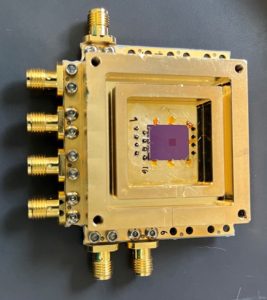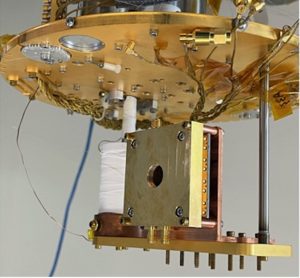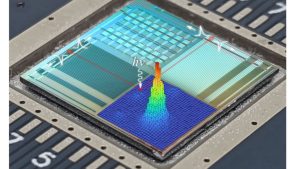At the intersection of quantum science and high-energy particle physics, advancements in the development and testing of the Superconducting Microwire Single-Photon Detector (SMSPD) could enhance detection capabilities for high-energy particles in particle physics experiments.
The quest to understand the fundamental constituents of the Universe – elementary particle physics and high-energy particle physics – is reaching a new frontier, driven by transformative advances in quantum science and technology (QST). This confluence of fields is creating unprecedented opportunities, particularly in instrumentation, detector design, and the search for physics beyond the Standard Model (BSM). Superconducting sensors (SNSPDs) optimised for charged particle detection will dramatically increase the capabilities for performing quantum tomography at colliders, allowing detailed detection of quantum entanglement and offering unique discovery potential for dark sector particles.
 The superconducting microwire single-photon detector, or SMSPD, – the small dark purple region – can precisely detect single particles at a time. The detectors were designed and fabricated at JPL and commissioned at the INQNET-Caltech labs
The superconducting microwire single-photon detector, or SMSPD, – the small dark purple region – can precisely detect single particles at a time. The detectors were designed and fabricated at JPL and commissioned at the INQNET-Caltech labs
Intersections of QIS and high-energy physics
The synergy between QST and HEP extends across theoretical and technological boundaries. On the theoretical side, Quantum Information Science provides an intellectual stimulus for innovative models that address deep questions about the quantum Universe. This includes developing entanglement-based field theory models, exploring tensor networks, and addressing issues like decoherence. Concepts from black hole physics, holographic correspondence, and quantum error corrections are converging to yield a deeper understanding of the Universe at its most fundamental level.
Crucially, the technological overlap focuses on using quantum metrology to detect the extremely faint signals characteristic of new physics. Traditional searches for dark matter, like the Weakly Interacting Massive Particle (WIMP) paradigm, relied on traditional scattering principles. However, the search for lighter dark matter candidates and new BSM particles requires the exquisite sensitivity of quantum devices. This new generation of experiments leverages devices like SQUIDs (Superconducting QUantum Interference Devices), Transition Edge Sensors (TESs), Microwave Kinetic Inductors (MKIDs), transmon qubits, and other quantum sensors to look for axions, dark photons, and other exotic phenomena. The most significant practical intersection in accelerator-based HEP, and the focus of this article, is the development of next-generation detectors that harness quantum effects to achieve unprecedented precision, with the recent example of the SMSPD arrays.
The quantum leap in detection: Initial SMSPD testing at Fermilab
Detecting high-energy particles like protons, electrons, and pions is a cornerstone of particle physics, yet traditional detectors often struggle with the simultaneous requirements of high sensitivity, fine spatial resolution, and picosecond-level time resolution. The Superconducting Nanowire Single Photon Detector (SNSPD) technology, which has revolutionised quantum information science and astronomy with its ultra-low energy threshold and exceptional timing, might offer a solution.
To bridge the gap between the small active area of traditional SNSPDs and the needs of large-scale accelerator experiments, researchers from Fermilab, Caltech, and JPL developed a modified type of device: SMSPD array. These devices utilise micrometer-width superconducting wires to create millimeter-square active areas — a significant scaling achievement.
The first detailed characterisation of the SMSPD arrays with GeV-energy particles was published in Journal of Instrumentation (JINST 20 P03001) in 2025. This foundational study exposed an SMSPD array, fabricated with 1.5 μm wide wires on a 3 nm tungsten silicide (WSi) film, to 120 GeV protons and 8 GeV electrons and pions at the Fermilab Test Beam Facility (FTBF). Key results from this pioneering work included:
A fill factor-normalised detection efficiency of 60%.
A time resolution of 1.15 ns, which demonstrated the technology’s potential for precision timing in HEP.
The use of a silicon tracking telescope provided precise spatial resolution, measuring 30 μm for protons and 130 μm for electrons and pions.
Advancing the state-of-the-art: The CERN test beam follow-up
The success at Fermilab led to an accelerated follow-up study at a premier international facility: the CERN Super Proton Synchrotron (SPS) H6 beam line. This subsequent work, detailed in the arXiv pre-print Towards High-Efficiency Particle Detection Using Superconducting Microwire Arrays (arXiv:2510.11725), focused on an improved sensor design.
The collaboration characterised a new 8-pixel 1×1 mm2 SMSPD array. This sensor featured a thicker, optimised 4.7 nm WSi film and narrower 1μm wide wires, aiming to enhance both detection efficiency and timing precision. The device was tested with 120 GeV hadrons and 120 GeV muons.
The results of the CERN test demonstrated significant performance gains, cementing the SMSPD’s status as a leading candidate for next-generation detectors:
Enhanced detection efficiency: The measured fill factor-normalised detection efficiency increased to approximately 75%.
Precision timing: The time resolution was measured to be a remarkable 130 ps accross the array — a notable improvement over the 1.5 ns achieved in the initial Fermilab tests.
Muon detection: This study also provided the first SMSPD detection efficiency measurement for muons.
These findings represent a major step towards developing high-efficiency charged particle tracking systems with simultaneous precision timing. Such detectors are vital for future accelerator-based experiments, including the Electron-Ion Collider (EIC), the Future Circular Collider (FCC-ee/hh), and a Muon Collider.
The path to a quantum future: The INQNET programme
The technological breakthroughs in superconducting sensors discussed here are not isolated projects but are part of a broader, long-term strategic vision to integrate quantum technologies into fundamental science, exemplified by the Intelligent Quantum Networks and Technologies (INQNET) research programme.
 The SMSPD is enclosed in a dark box to reduce backgrounds. The detector is attached to the cold stage of the cryocooler, which keeps the temperature at around 0.8 Kelvin. The particle beam enters through the hole in the centre
The SMSPD is enclosed in a dark box to reduce backgrounds. The detector is attached to the cold stage of the cryocooler, which keeps the temperature at around 0.8 Kelvin. The particle beam enters through the hole in the centre
INQNET was jointly founded in 2017 by the California Institute of Technology (Caltech) and AT&T. The programme’s strength lies in its unique, collaborative model that brings together leading institutions from academia, industry, and national laboratories. Fermilab (FNAL) and NASA’s Jet Propulsion Laboratory (JPL), managed by Caltech, were the initial, essential founding members of the collaboration.
This partnership leverages the respective strengths of the members: industry for rapid resource allocation and scaling, academia for fundamental research, and national laboratories for large-scale infrastructure and deployments, and other experimental capabilities.
 A graphic representation of a scalable readout architecture for superconducting nanowire single photon detectors designed and demonstrated as part of a NIST – JPL collaboration
A graphic representation of a scalable readout architecture for superconducting nanowire single photon detectors designed and demonstrated as part of a NIST – JPL collaboration
INQNET’s core mission is to accelerate the development of scalable hybrid quantum networking and communications technologies, with early focuses on quantum networks and communications. The programme has been instrumental in establishing quantum network test beds, such as the Fermilab Quantum Network (FQNET), which have demonstrated high-fidelity quantum teleportation over optical fibre. The sensor technologies — the same ones now proving capable of high-energy particle detection – were initially developed at JPL and commissioned at INQNET-Caltech labs, underscoring the deep connection between quantum sensing for HEP and the broader effort to build a quantum internet.
This type of consortium programme provides the necessary research and technology development framework to drive the fundamentals of quantum physics into functional, advanced technologies. How this research is successfully integrated into the next generation of experiments promising to unlock new discoveries about the fundamental nature of matter, energy, space, and time is an open challenge and opportunity.
Please note, this article will also appear in the 24th edition of our quarterly publication.

